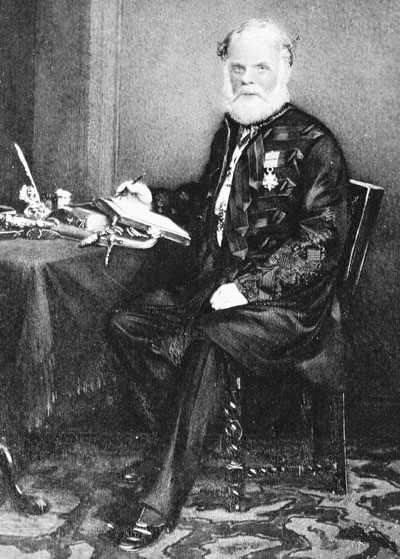 |
My maternal great-grandfather General Henry Selby Rickards in uniform, also known as ‘Abdallah Pasha, il Ingilizi’, the Englishman who served the Khedive rulers of Egypt, who were themselves under the nominal control of the Ottoman Empire. He was born in Colchester 1819. Spent most of his working life in Egypt spent his last years in Beyrouth (part of Greater Syria) where he died in 1886. Buried there with his English wife Catherine who died some years later, who is buried next to him.
below one of his medals in my possession.
below one of his medals in my possession.
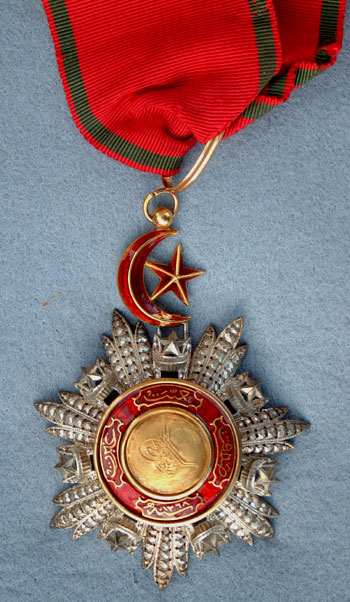 |
Order of the Mecidiye: Ottoman (Turkish) Order instituted 1852. (centre is Gold) and inscribed: Zeal, Devotion, Loyalty and the Muslim date, 1268. Awarded to General Henry Selby Rickards later known as Abdallah Pasha, il Ingilizi.
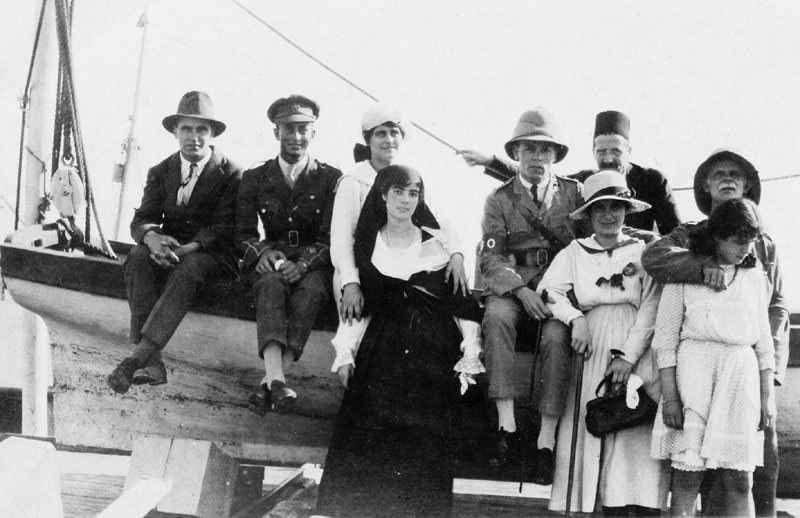 |
SS Carniola before departure from Alexandria for Mersina July 1919.
From left back row - William Rickards, British Officer, Olga Rickards, Uncle Amin Abd’Allah,
front row - cousin Seza Nabarrawi, cousin Bertie, Dosia Rickards, Henry Rickards with youngest daughter Rosie.
From left back row - William Rickards, British Officer, Olga Rickards, Uncle Amin Abd’Allah,
front row - cousin Seza Nabarrawi, cousin Bertie, Dosia Rickards, Henry Rickards with youngest daughter Rosie.
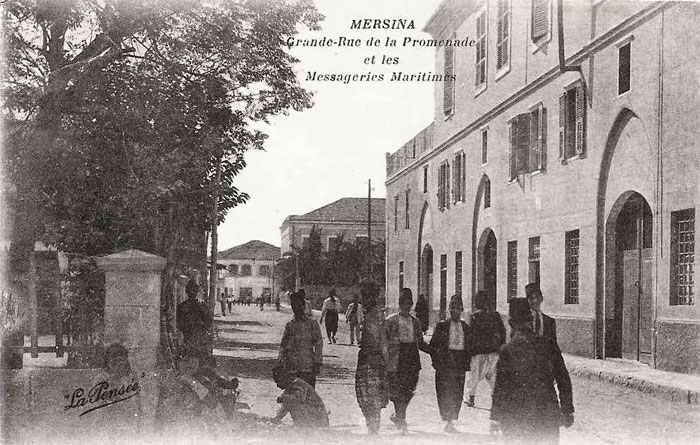 |
Sea front road, the old Kisla Caddesi - ‘Grande-Rue de la Promenade et les Messageries Maritime’. The large building beyond the trees on the right was the home of the Tahinci family. This was the biggest and most prestigous home in Mersin with magnificent marble stair-case, and many of the walls and ceilings were covered with exquisite images painted in oil fitingly perhaps, the place is now a museum, the Ataturk muzesi. Beyond this the Rickards houses.
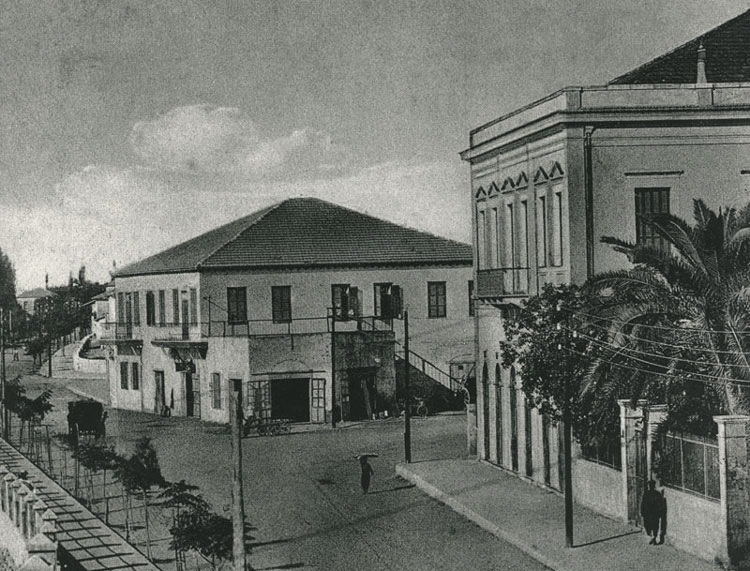 |
A closer view of Tahinci property and beyond one of the Rickards houses. The Tahinci house was built by the then German consul Christmann. In 1992, it was transformed into a museum in recognition of the fact that Ataturk stayed in this house when he visited the city in 1925.
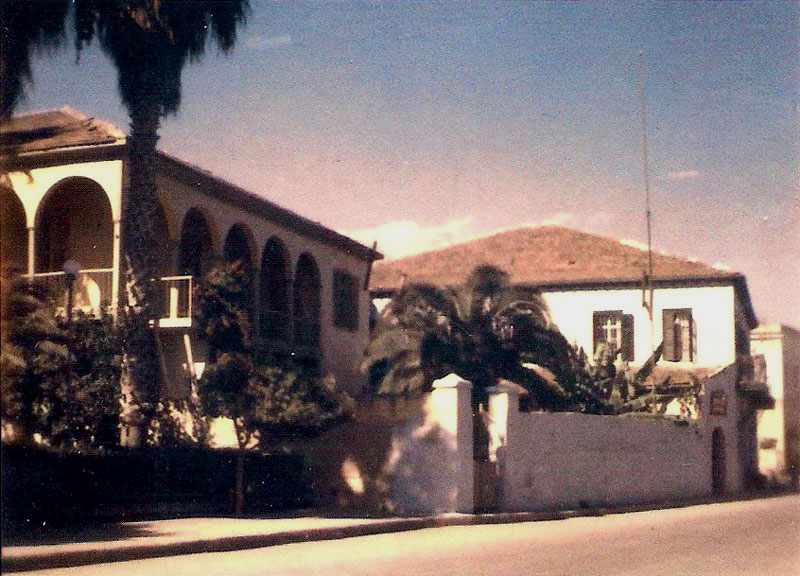 |
Close up view of the two Rickards houses, built circa. 1893 by his father in law Hanna Kerroum. Both only a few meters from the sea to the right of the picture.
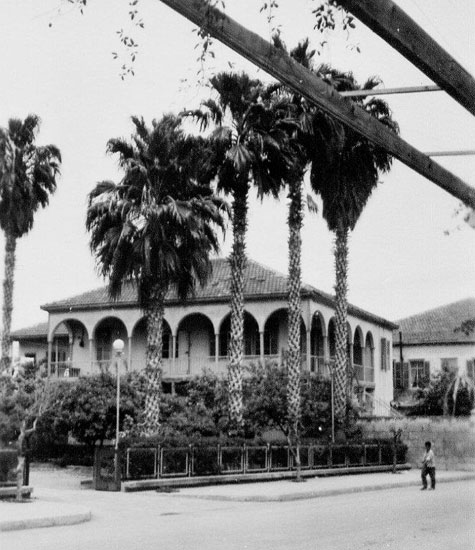 |
View of one of the Rickards houses with its balconies and picturesque arches which at one time had been listed as a protected property.
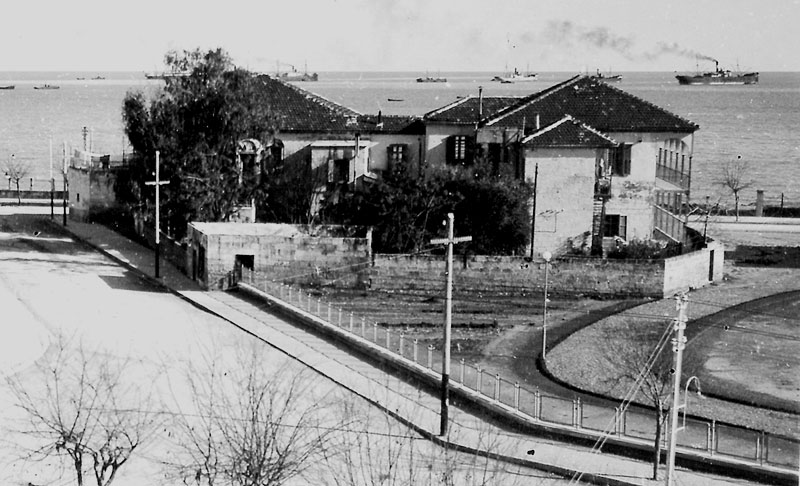 |
The Rickards houses occupying the corner site before the construction of the substantial Vali Konağı, circa 1930s, as seen from the Silifke Caddesi. This shows the very close proximity of the sea and gives an idea of how visiting ships were anchored in the then open roadstead. Few vessels, compared with the many that called in later years. The derelict roofless building in fore ground had once served as an early Fırın [bakery], before electrification and later as a carpentry shop.
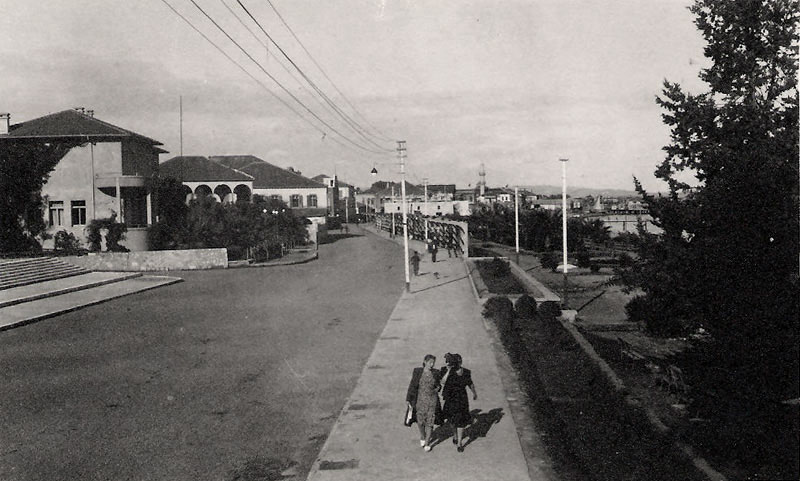 |
Mersin main sea front road (1950s), looking East down road, first on left Vilayet (Vali’s house). Next, two Rickards homes first of which has arches.
Note: The views that follow are westerly and in the direction that the two ladies are heading.
Note: The views that follow are westerly and in the direction that the two ladies are heading.
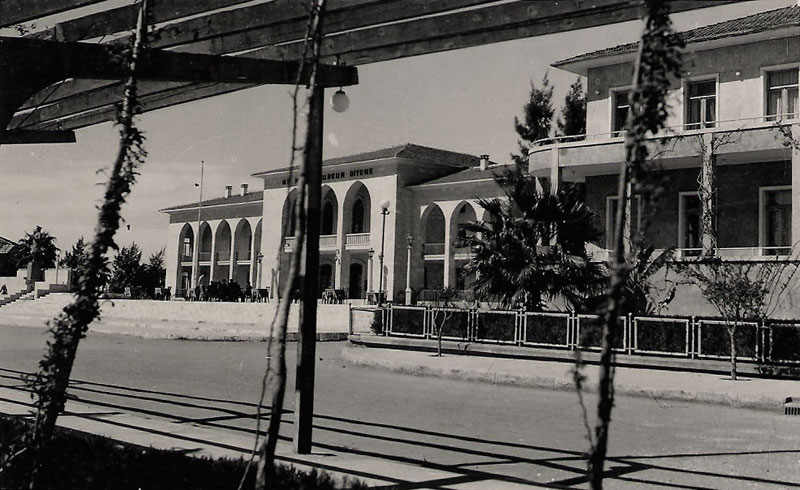 |
The very impressive ‘Halk Evi’ [community centre] is built on a substantial plot of land that at one time in the 1930s was known as the ‘Çardak Mahallesi’ [modest wooden building quarter] which were razed and replaced by this building in the early 1940s. The large building to the extreme right of the image is the Vali Konağı, once home of my ilkokul friend Yalçın.
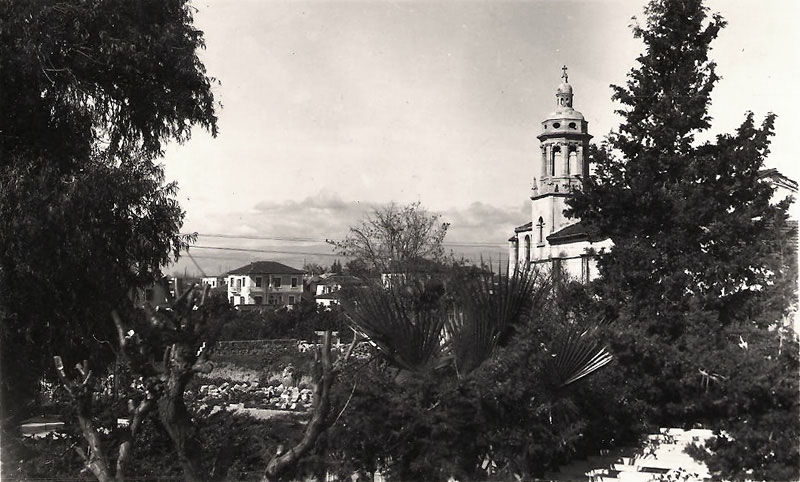 |
Imposing view of the Syrian Orthodox church taken from the pavilion inside the Aile Bahçesi ie. ‘Family Garden’ a pleasant cafe where church goers once flocked to before its demise.
 |
Once known as Kışla Caddesi sometime between the Wars changed to Atatürk Caddesi, conspicuously deserted in this photograph, sedate with only the occasional horse drawn carriage this corniche served the residential sea front quarter of Mersin. Just past the Syrian Orthodox Church and immediately to the right of the view of the crossroads was the Toroğlu House (see below for an early view - the white house in the corner) which my school friend, Atilla Toroğlu has replaced with a multi-story block of flats where he now resides. Running parallel, the back road, Silifke Caddesi teamed with horse drawn carts, camel trains and pack horses all jostling in their haste to deliver their goods to the jetties or the yogurt bazar and big covered market. The houses on the left, just visible behind the low walls, beyond their tennis courts were the residences of the Nakash families (Christian Syrian), sharing the maritime businesses with the Levantes. The larger building further down was owned by the local Çifçi family, indigenous to the region who were reputed to be the first multi-millionaires of Mersin. During the war the bottom flat was occupied by Major Bertie John Cotton, acting British Consul at the time and his wife Olga nee Rickards, my aunt.
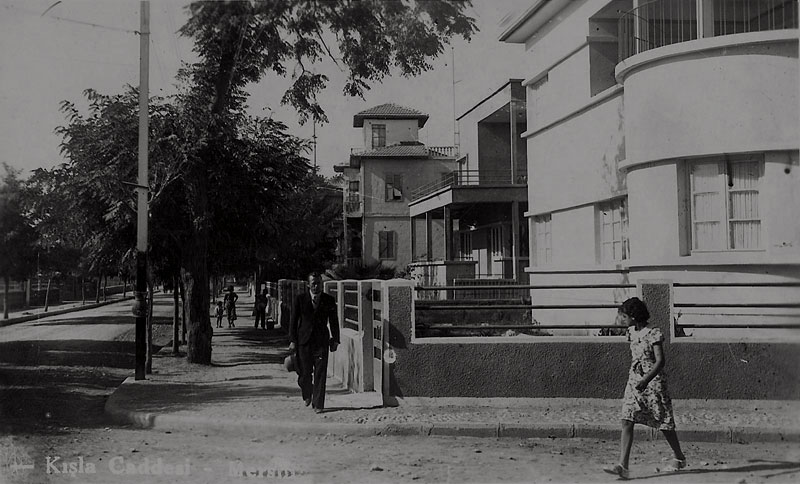 |
On the same stretch, the side street is like the rung of a ladder leading to the main back road, Silifke Caddesi. It comes out bang opposite the Gazi Paşa İlkokulu. Emilio Levante grew up in the next house down in the 1940s. Also during the same period the house further down, the upper floors were the home of Geoffrey Maltass and his wife Audrey nee La Fontaine who was earlier married to William Giraud of Bornova, Izmir.
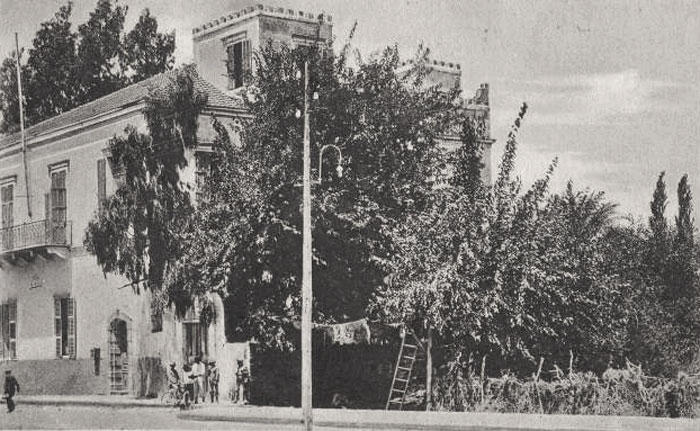 |
This was the former Gazi Paşa İlkokulu [primary school], the school as it was in the late 1930s / early 1940s when Atilla Toroğlu and I were pupils there. At the time it was co-educational. It was burnt down in 1960 and has been rebuilt but I have not seen it in its new state. The substantial stone built two storey building with its twin square towers is said to have been built in 1905 as a home for Hanna Butrous and his family. I recall the entrance to the big schoolyard off the Silifke Caddesi and just inside the grounds, the impressive marble steps that led up to the building’s main entrance. In those days, where the vast and impressive Halk Evi now stands in its grounds, there were modest dwellings known by locals are Çardak mahallesi.
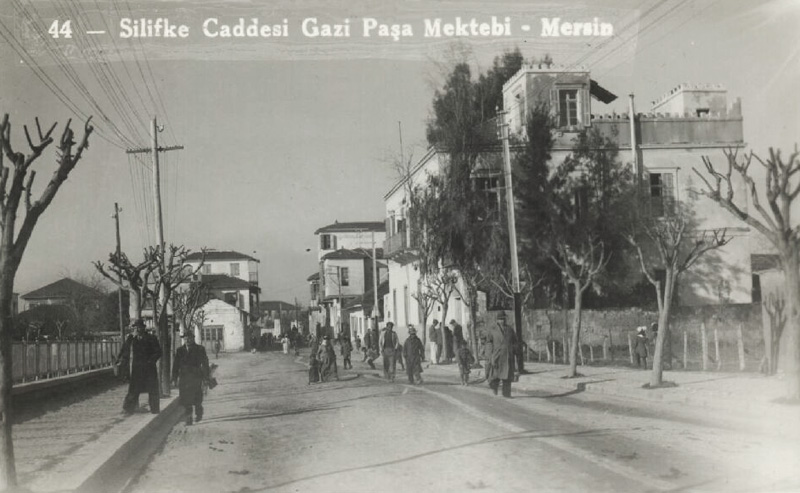 |
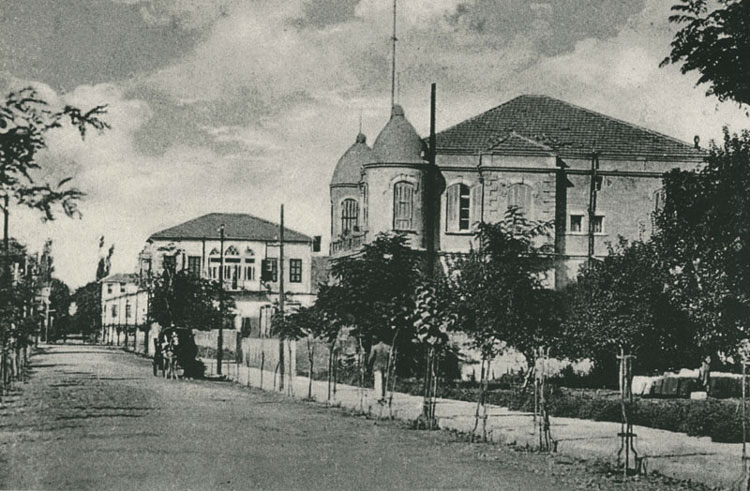 |
The lofty trees at the very end form what was in the earliest days known as the Rond-Point [French for roundabout], now the residential centre of Çamlıbel quarter of old Mersin.
The former Nacar house / Chachaty House, seen to the right of the road was built in 1905.
The former Nacar house / Chachaty House, seen to the right of the road was built in 1905.
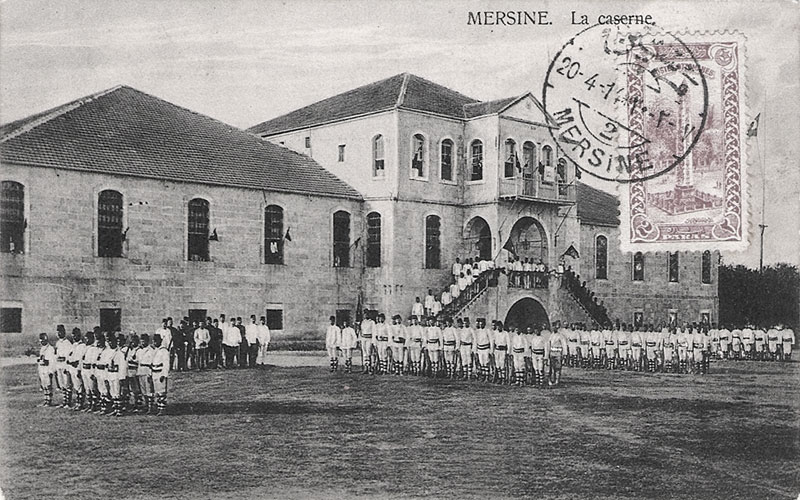 |
The old barracks of Mersina, once on the western edge of the city. The large buildings shown, leave alone the soldiers, could not be seen by prying eyes from outside the compound. I recall a high wall (almost 3 m high) screened them off from the main Kışla Caddesi, this wall high as it was, ran the length of the Kışla Caddesi and closely bordered the road, in other words, it was a very effective screen. The Mediterranean on the otherside presumably served a similar purpose. From my earliest days in Mersin, my mother used to occasionally take me for walks past the Kışla with the high stone wall treated with ‘badana’ [white-washed]. I only once went in, past the guards at the entrance. It must have been on one of the early anniversaries of Ataturk, Mustafa Kemal’s death (10th Nov) that I accompanied my aunt Olga to lay a wreath at his statue. She had not long been married to the British Pro Consul, a Captain John Catton, and I recall getting into one of official ‘paytons’ [horse-carriage] with the bulky garland. Formalities at the entrance quickly over, as we approached the spot my aunt whispered, “Now, remember stand to attention and give a smart salute”. My mother used to tell me of earlier times, when my grand father Henry Rickards and the family were friendly with the barracks Commandant named Cebeci. He had a great love for growing roses. The small plot set aside for their cultivation is said to have benefitted greatly from the adjoining stables. Incidentally, the troops in the postcard are all wearing the fez. Certainly the picture pre-dates 1923 and could have been taken before the 1st World War.
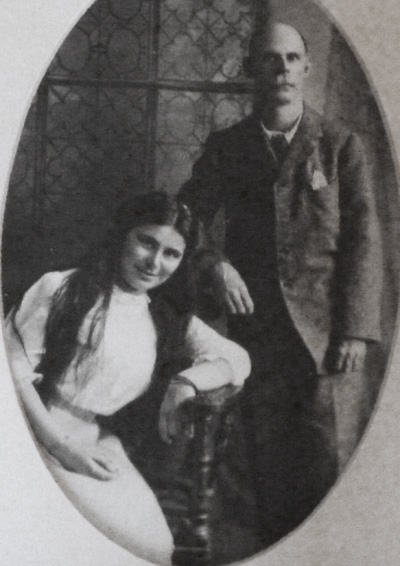 |
My grandfather Henry Rogers Rickards and his daughter, my mother Dosia before marriage, aged around 17 in Mersin.
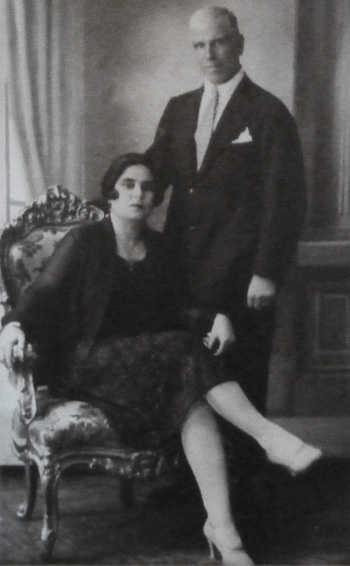 |
My parents Dosia and Captain ‘Harry’ Grigsby.
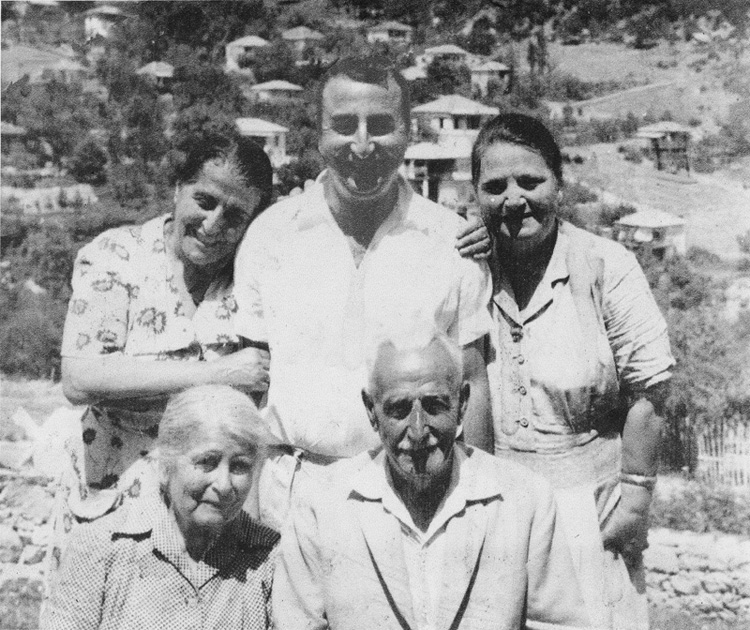 |
Bottom left: Mariam Rickards (maternal grandmother), bottom right: Tannus Farris (husband of Mariam’s sister Footine).
Top left to right: Saada Hanni (daughter of Tannus), Salim Farris (son of Tannus), Dosia Grigsby (Mariam’s eldest daughter), with the houses of Gözne in the background.
Top left to right: Saada Hanni (daughter of Tannus), Salim Farris (son of Tannus), Dosia Grigsby (Mariam’s eldest daughter), with the houses of Gözne in the background.
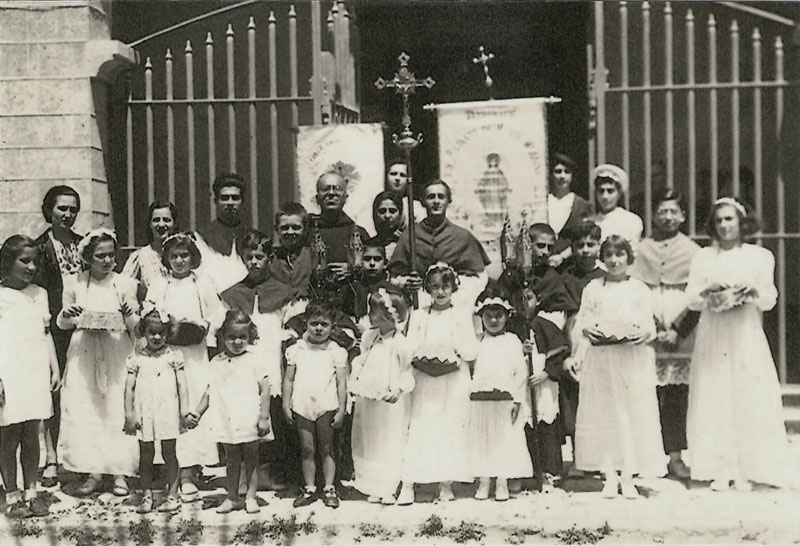 |
Pere Paul, the long serving Catholic priest (immediately in front of banner on left) with the many altar boys and servers outside the massive steel gates of the Cathedral like St. Antoine Catholic church circa 1940, that is in the eastern extremity of old Mersin, near the station. The two boys to the right of the picture were contemporaries of mine, the big boy with spectacles is Sandro Chelfoun sometimes known as ‘serpent a lunettes’ but me closest contemporary is to his right, Paul Debbane always called PoPaul.
 |
PoPaul and I are at the front and his sister Rosie just behind with their mother, Madame Angele Debbane knealing. Behind from the left Nadia from Beirut, the then
young bride of Edouard Butrous, Giselle Chelfoun, Madame Virginie Chelfoun and Madame Dosia my mother.
Madame Chelfoun is smoking a Pipe, as was her custom!!!
Madame Chelfoun is smoking a Pipe, as was her custom!!!
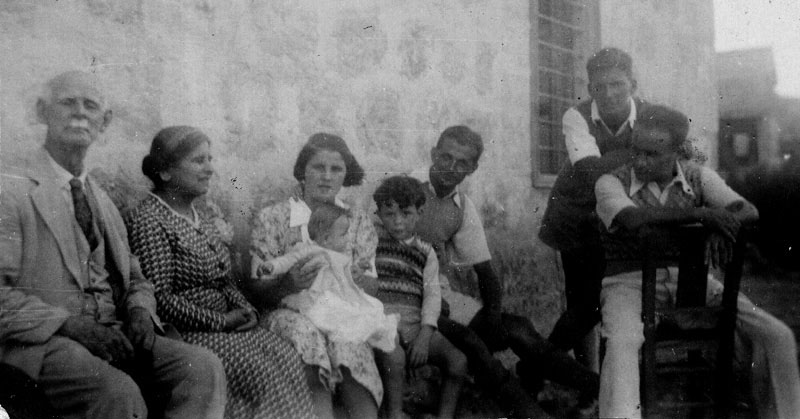 |
Customary daily scene outside Rickards summer house in Gözne, at sunset. 1939/40.
From left - Henry Rickards and Mariam, Rosie nursing baby Emilio Maria with me seated, Ronnie Lochner seated at end.
Eitel Lochner standing behind Riri Levante (Rosie’s husband) sitting on chair. Ronnie and Eitel were brothers, sons of Reinhard (aka Renee) Lochner and Evelyn (nee de Caravel).
From left - Henry Rickards and Mariam, Rosie nursing baby Emilio Maria with me seated, Ronnie Lochner seated at end.
Eitel Lochner standing behind Riri Levante (Rosie’s husband) sitting on chair. Ronnie and Eitel were brothers, sons of Reinhard (aka Renee) Lochner and Evelyn (nee de Caravel).
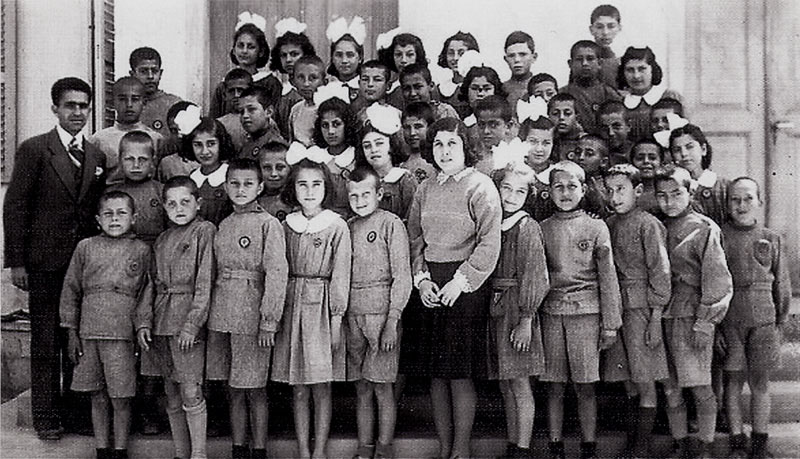 |
Patrick Grigsby (back row, 4th from the right) with his class-mates at Gazi Paşa School with teacher Fatma Ergelen, Mersin around 1940. My friend I am still in touch with is Atilla Toroğlu (front row, 4th from the right) provided the photo. The girl next to me is Victoria Dellül (Christian Arab), she is now my son-in-law Semir’s mother! The man on the left is the head-master Ali Fuat Fırat, a proud Kurd! Atilla Toroğlu finished his education at the American College and worked at the American base at İncirlik near Adana most of his life.
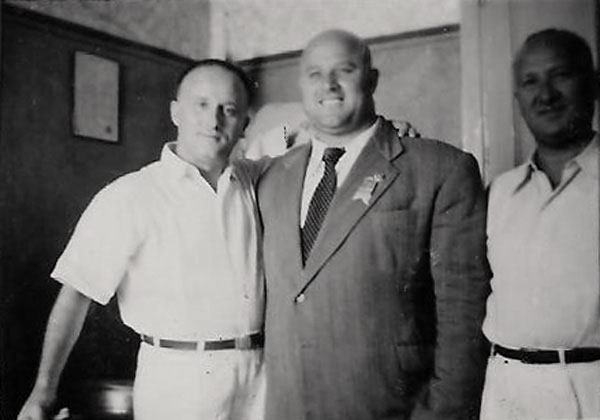 |
Mersinli Ahmet, world Greco-Roman wrestling champion at 1948 London Olympics. To his right my uncle Riri Levante, the other side Edmondo Levante - more information on this family:
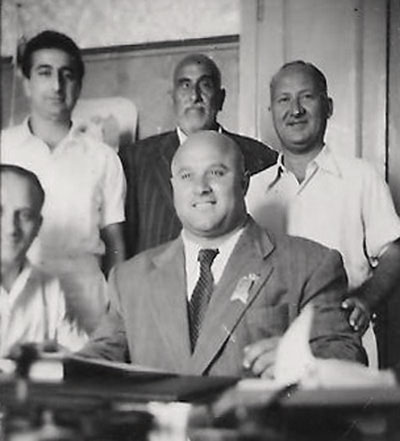 |
Mersinli Ahmet sitting at Levante Offices amidst his supporters, from left: - Riri Levante, Selim Faris Salman, office bekçi [guard] in jacket Abu Aşur, and Edmondo Levante.
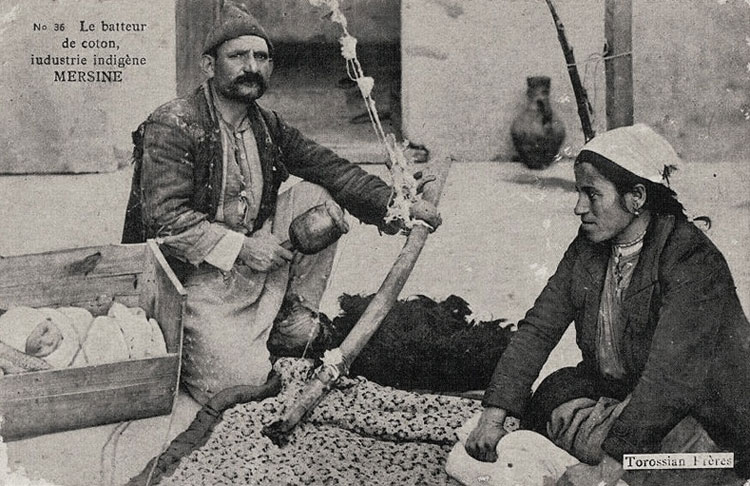 |
An interesting, and now almost certainly a unique sight. Even at the time I am speaking of hardly what would have then been described as ‘industrie indigene’. The ‘cotton beater’ with his bow shaped device and wooden mallet that he used to fluff up the compacted cotton from mattresses that people in Mersin had slept on. In the photograph taken for ‘Torossian Freres’ postcard it is worth pointing out that there is no cotton, the very subject of the process, to be seen any where. The ‘pumuk attıran’ as he was then called, is accompanied by his assistant, usually a female relative. It would have been my grandmother Mariam who would have hired them to come and attend to all our mattresses. Probably a good days hard and dusty work down in the wash house on the ground floor of my grandfather Rickards’ house where I grew up (circa 1930-1940s). They would start by cutting one end of the mattress open and remove the cotton stuffing. The process was really a way of aerating the matted cotton once it was heaped on the floor
The aeration took place by the man beating the bow string, whilst it was in contact with the cotton, using his mallet. This, one might say ‘strumming’ produced a characteristic loud twanging sound. It also created a considerable amount of airborn dust that remained in suspension for a considerable time. Long before an awareness of such hazards, it is hard to say what precautions the impoverished ‘pamuk attıran’ and his assistant might have taken whilst working. The airborn dust must have been why the photograph was not taken ‘live’ whlist the process was going on.
The aeration took place by the man beating the bow string, whilst it was in contact with the cotton, using his mallet. This, one might say ‘strumming’ produced a characteristic loud twanging sound. It also created a considerable amount of airborn dust that remained in suspension for a considerable time. Long before an awareness of such hazards, it is hard to say what precautions the impoverished ‘pamuk attıran’ and his assistant might have taken whilst working. The airborn dust must have been why the photograph was not taken ‘live’ whlist the process was going on.
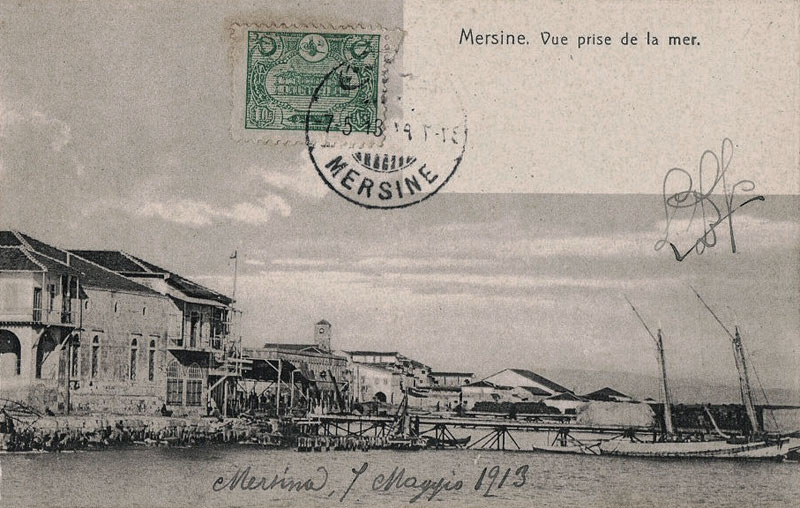 |
This view of Mersina, taken in 1913 from the sea shows the early beginnings of its maritime development. The tower of the Catholic Church can be seen above the buildings in the foreground and are most likely to have been by the ‘Gümrük meydanı'’, a prominent square in the commercial town centre. Also where Henry Rickards known affectionately by the locals as ‘topal İngiliz’ (the lame Englishman) owned a row of shops and the once popular Ak Deniz Oteli.
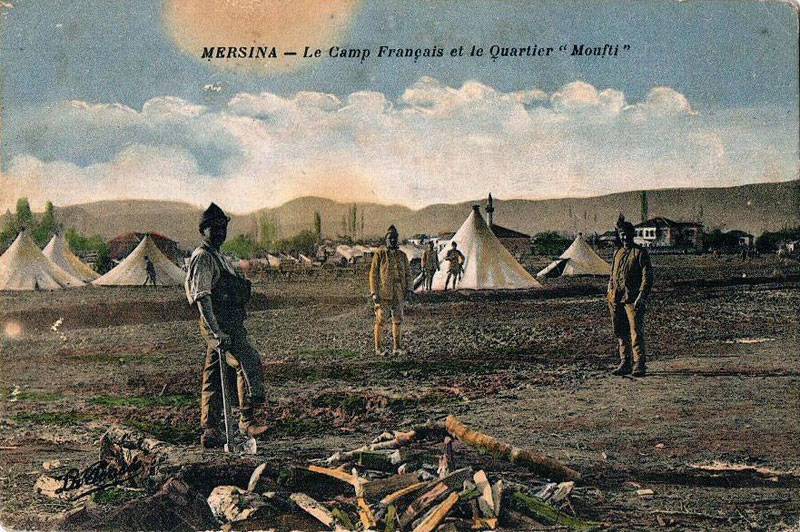 |
The two Rickards houses on the corniche road in Mersin during the first World War (1914-18) were commandeered by the French and used as their HQ. From what I heard as a child, the occupying forces in the region did not penetrate very deep into ‘the interior’, preferring to remain close to the Mediterranean coast. The Rickards property was ideal, giving them a foothold from which to direct the naval shelling of the ‘çete’ (pronounced chette), an irregular force of guerrillas in the foot hills of the Taurus Mountains. The French troops seen in the postcard are said to have been in the Mufti quarter. Judging by the terrain not far from the river in the vicinity of the barracks and Mufti bridge. At the time the outskirts of Mersin to the West.
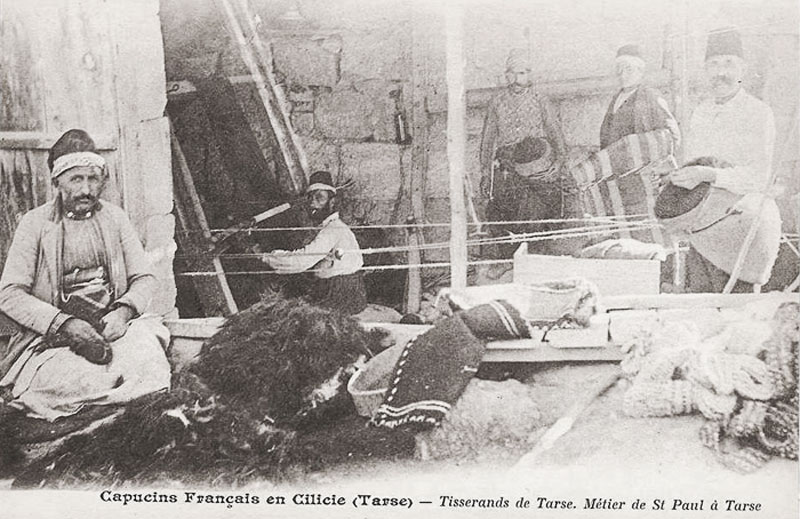 |
What is interesting about the llustration on this carte postale is that the weavers are said to be French mendicant Friars. They have evidently come on a mission to Cilicia, a historic region in the South East of what is now Turkey and includes Mersin, Tarsus and Adana. They live solely on alms. Spending their days weaving materials just like the most famous of Tarsus’s sons, Saint Paul is said to have done in his time there.
In August 1968, I drove by car across Europe heading for Istanbul, with my wife and three daughters. At the time all three of them, Nicola, Diana and the youngest Rachel, seen in the adjoining photograph were at St. Paul’s Convent School in Sutton Coldfield. Our final destination was the Mediterranean coastal town of Mersin where my family lived. The biblical town of Tarsus was only about 20 km from Mersin and a magnet for all visitors to that region.
In August 1968, I drove by car across Europe heading for Istanbul, with my wife and three daughters. At the time all three of them, Nicola, Diana and the youngest Rachel, seen in the adjoining photograph were at St. Paul’s Convent School in Sutton Coldfield. Our final destination was the Mediterranean coastal town of Mersin where my family lived. The biblical town of Tarsus was only about 20 km from Mersin and a magnet for all visitors to that region.
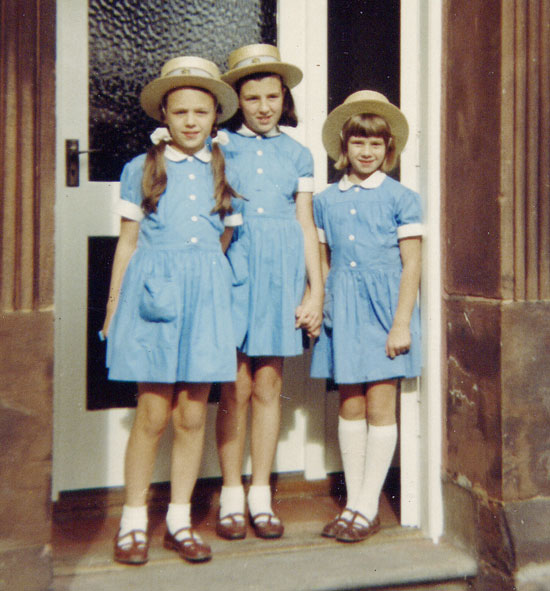 |
Our three Grigsby daughters standing in porch of Ashdene home.
From left: Diana - Nicola eldest - Rachel youngest.
On returning to to St. Paul’s Convent that September term Rachel could not wait to tell her form teacher, Sister Tartissius, of her visit to Tarsus where Saint Paul had once lived. Finding it hard to digest, the reverend Sister reprimanded her, “You wicked girl telling such lies”. It was not long before Sister Tartissius discovered that Rachel had indeed been to Tarsus. She apologised but she also wanted to hear more about her little pupil’s “unexpected pilgrimage”.
From left: Diana - Nicola eldest - Rachel youngest.
On returning to to St. Paul’s Convent that September term Rachel could not wait to tell her form teacher, Sister Tartissius, of her visit to Tarsus where Saint Paul had once lived. Finding it hard to digest, the reverend Sister reprimanded her, “You wicked girl telling such lies”. It was not long before Sister Tartissius discovered that Rachel had indeed been to Tarsus. She apologised but she also wanted to hear more about her little pupil’s “unexpected pilgrimage”.
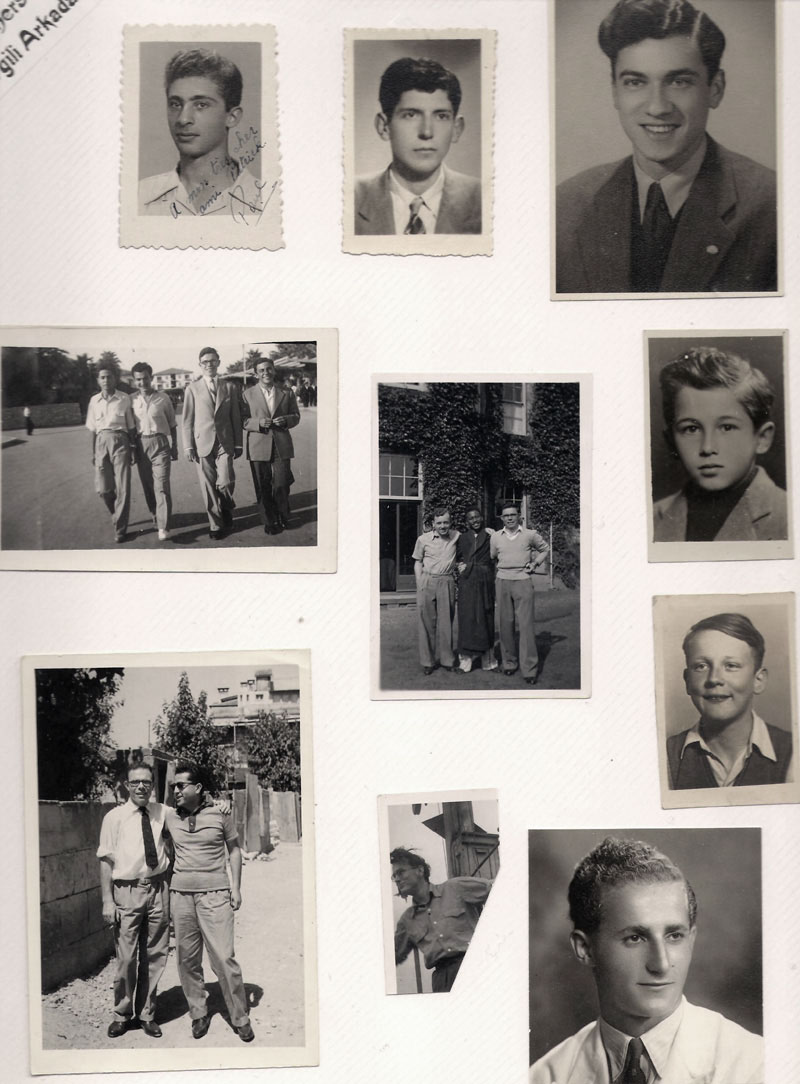 |
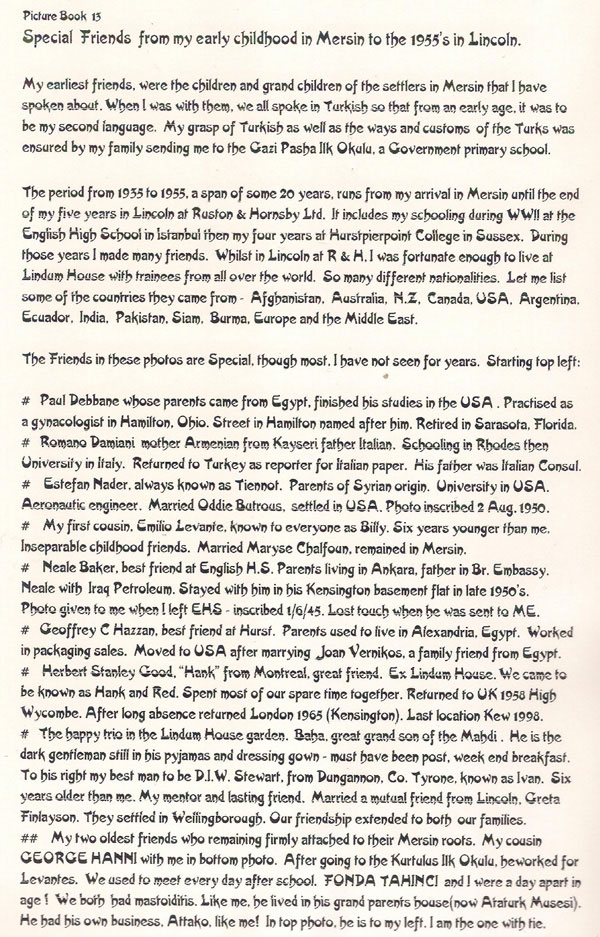 |
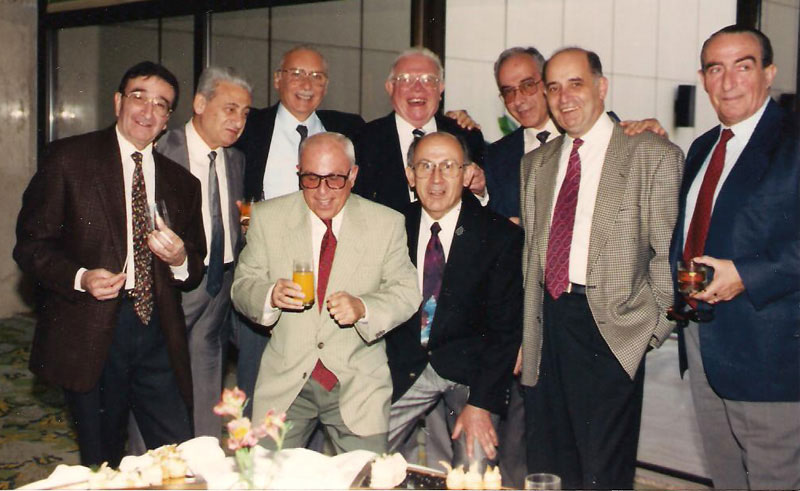 |
1995 Reunion at Mersin Hilton hosted by Dr. Paul Debbane (USA) and Dr. Gabriel Meruoi (Canada) with their childhood friends. From left clockwise: Albert Butrous, Henri Haddad, Dr. Paul, myself, unidentified, Yukie Nader, unidentified, Dr. Gabriel and Fonda Tahinci.
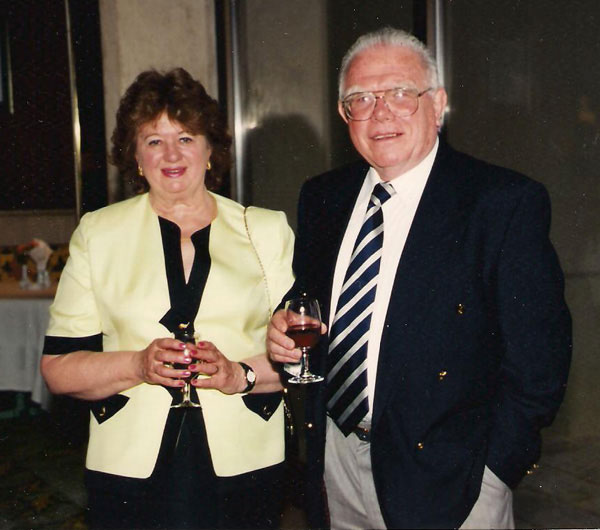 |
My wife Beryl and I at the same 1995 Reunion on our then frequent visits to Mersin.